#common wildebeest
Explore tagged Tumblr posts
Text

Common Wildebeest | Chad Cocking
#photo#bovidae#antilopinae#connochaetes#connochaetes taurinus#common wildebeest#the herd#juvenile#multigenerational#chad cocking
26 notes
·
View notes
Text



White-backed Vulture | Ahmed Galal
#carcass#accipitridae#bovidae#aegypiinae#antilopinae#connochaetes#gyps#gyp africanus#connochaetes taurinus#common wildebeest#white backed vulture#ahmed galal
11 notes
·
View notes
Note
You get to see zebras on your route?? That's really neat!
yeah!!! :D the bus drives by the zoo, and the fences are juuust high enough that you can't see through them when driving in a regular car (as to not distract the drivers), but you can as a bus passenger if you sit at the right spots!
i also see rhinos sometimes tho those are pretty rare hehe.
6 notes
·
View notes
Text
A Gentle Song in the Woods: A Silver Thought
I'm gonna be honest, the ocarina is like the PERFECT instrument for Silver and I sorta thought to myself one day before the update,
"If there's an instrument I could see Silver playing, it would definitely be a wind instrument."
I'm so glad my little HC was right.
So, to make up for the Malleus angst, I wanna treat the Silver fans since AUGH HE'S SO PRECIOUS!!!! Hope you enjoy! Oh yeah, slight Book 7 spoilers ahead!
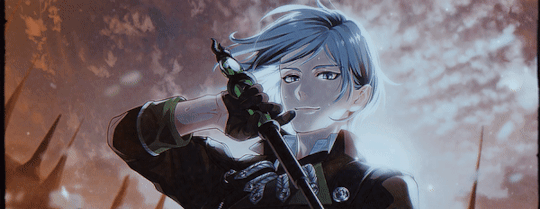
Early morning creeps up but alas, with Grim snoring in your ear you could barely get a wink. Not to mention, Crewel just HAD to require his little pups to get some ingredients from the woods behind the campus in order to complete an experiment.
Wanting to save yourself the trouble, you decide to go at the crack of dawn in an effort to get the freshest and first pick of the day before the other students come stampeding like a pack of wildebeests.
These woods were nothing new to you (after all, you and your best friends nearly died in the mine on your first day of school) but compared to the rowdiness the other boys bring, it was a nice little spot to get some peace and quiet.
The sunrise as you made your trek painted the sky in the most gorgeous shades of blue, orange, and hints of pink and violet. Kinda reminds you of someone you know doesn't it?
But then, much like the light breeze playing around with the canopy of leaves above you as well as the gentle song of birds chirping, you hear... Another song? Common sense should tell you that if you hear music in the woods, turn back and run like hell but the slow and gentle rhythm made you all the more curious to see where it was coming from.
Deeper, and deeper you trek down the forest, you find a familiar face sitting by a tree with a circle of animals around him as an audience.
Honestly, who could blame the animals when Silver had such a peaceful aura to him? With the how the morning rays cast down on his hair and on his gentle face, coupled with the ocarina he was playing, one could easily mistake him for an angel walking on the earth. There's no mistaking that he's just so beautiful inside and out.
Although, the animals took notice of your presence when the music stopped and they hastily scampered away while Silver himself was rendered a little surprised seeing you but greeted you with a polite "Good morning, prefect" anyway.
Feeling a little bad for surprising him as well as the animals, you apologize, telling him that you didn't mean to startle him and you recalled your curiosity about the song he was playing.
"When I was little, I caught Father playing this song one night. From what I can remember, he said that it was a song from his youth so I wanted to learn how to play it."
You giggled picturing the scene in your head. A little toddling Silver sitting by the front yard of the cottage they lived in and Lilia's patiently teaching him that song on the ocarina while the young boy had a big smile on his face. From all the stories the old bat fae tells you about Malleus, Silver, and Sebek, they must've been cute kids.
Still, you applauded him. Telling him that he played beautifully and oddly enough, an ocarina suited him extremely well the more you got to know him.
In turn, he gave his gentle but awkward smile and replied saying,
"Thank you."
#twisted wonderland#disney twisted wonderland#disney twst#twst#twst thoughts#diasomnia#silver#twst silver#if anyone wants to know the song Silver was playing#i'll say it's an old Briar Valley song that was made in memory of the soldiers that died in the war against the silver owls#silver x reader#twst silver x reader#silver vanrouge#twisted wonderland silver
59 notes
·
View notes
Text
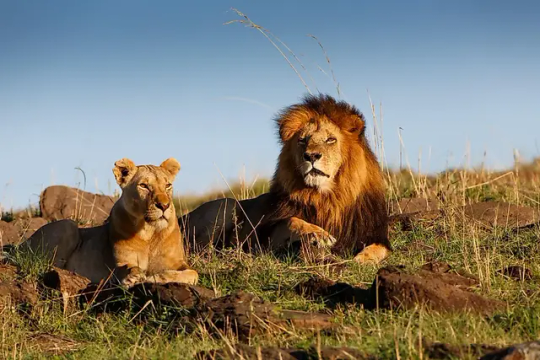



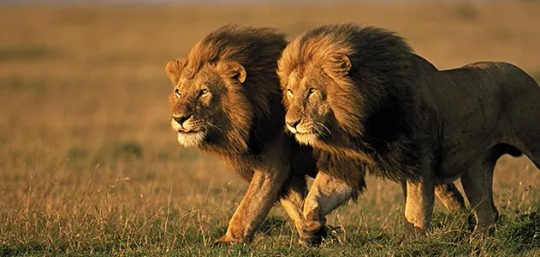
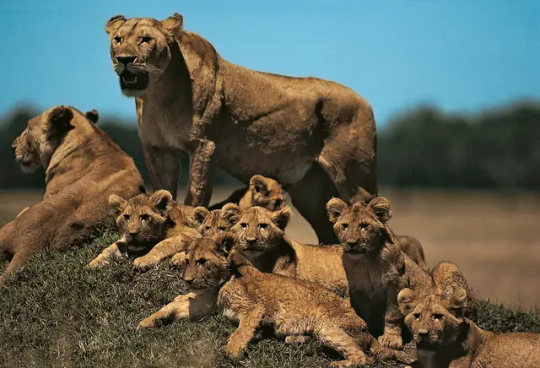
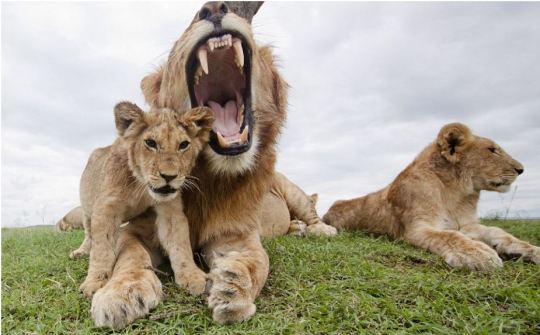

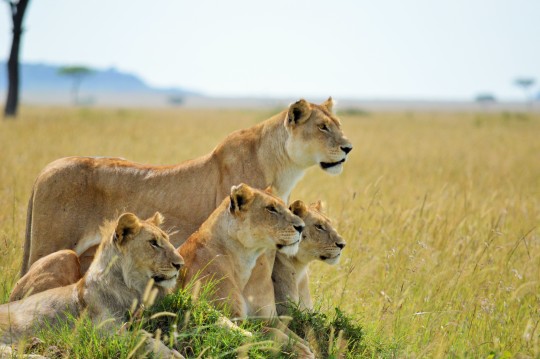
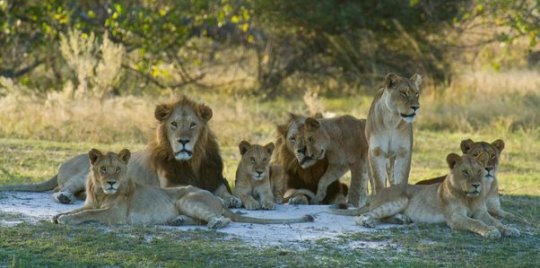
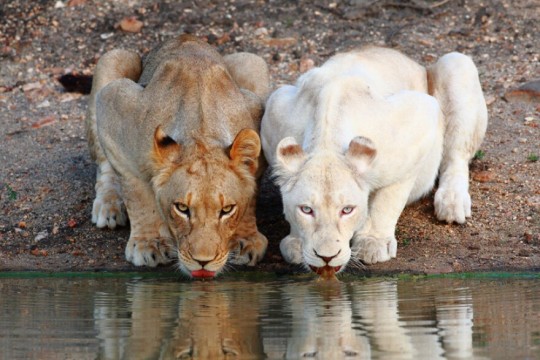
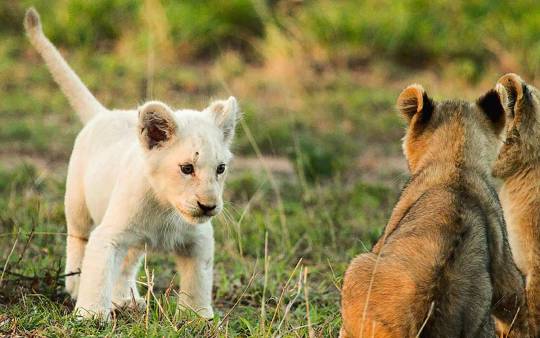
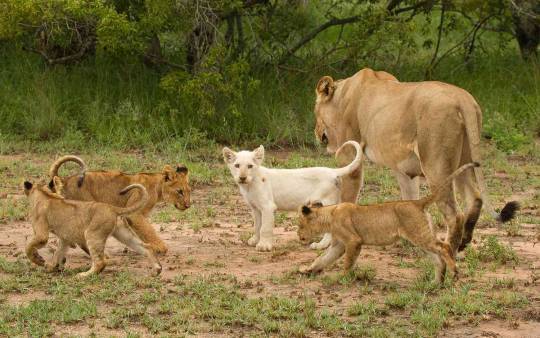
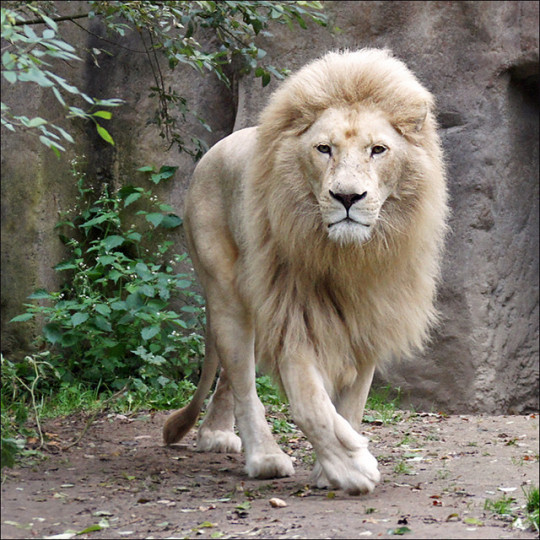
Panthera leo melanochaita better known as the east African lion, the Southern lion, the Southern African lion, or the East-Southern African lion,, is a subspecies of lion native to eastern and southern Africa. Here they prefer to inhabit grasslands and savannas, but are also known to inhabit open woodland, scrublands, and montane forests. African lions are the most social of all wild felines, living in groups of related individuals and their offspring called prides which number 3 to 30 females and 1 to 4 males. East African lions typically prey upon ungulates such as wildebeest, cape buffalo, eland, gemsbok, nyala, roan and sable antelope, warthogs, bush pigs, zebra, tsessebe, waterbuck, kudu, hartebeest, kob, and thomson’s gazelle, however they are also known to hunt other prey from as small as common mice to as large as young or infirm African bush elephants. Lions are themselves occasionally killed by other predators such as wild dogs, hyenas, leopards, other lions, and crocodiles. Female east African lions average around 7.5 to 8.9ft (2.3 to 2.7m) in length, and 183 to 370lbs (83 to 168kgs) in weight while males average around 8.1 to 9.4ft (2.47 to 2.84m) in length and 321 to 496lbs (145 to 225kgs) in weight, however lions as big as 11ft (3.35m) and 825lbs (375kgs) have been known to exist. This marks the lion as the second largest extant cat after the tiger. The lion is a muscular, broad-chested cat with a short, rounded head, a reduced neck, and round ears. The fur varies in color from light buff to silvery grey, yellowish red, and dark brown, additionally albino and leucistic individuals are not unheard of. Mature males typically sport long flowing manes, but may occasionally lack them. Additionally females may occasionally grown manes as well. Breeding may occur year round, with each mature female having there own estrous cycle. When in heat she will breed with one or more partners. After a 110 day pregnancy a mother lion will give birth to 1 to 4 cubs in a secluded den away from the rest of the pride. She will not rejoin the pride until her young are around 6 to 8 weeks of age. East African Lions reach maturity around 2 to 4 years of age, at which point the males are typically forcibly evicted from the pride and females may choose to set of in search of another to join. Under ideal conditions an east African lion may live up to 18 years.
#pleistocene pride#pleistocene#pliestocene pride#pliestocene#cenozoic#ice age#stone age#mammal#lion#africa#african lion#east african lion#white lion#cub#lioness#cat#big cats#feline
42 notes
·
View notes
Text
Worldbuilding: Running Hot and Cold
So, of the creatures you’ve invented for your world - are they ectothermic or endothermic?
“Cold-blooded” and “warm-blooded” are the colloquial terms for it. They’re... not exactly wrong, but incomplete. A “cold-blooded” critter simply does not have internal workings devoted to keeping it inside a specific band of temperatures No Matter What. (Though some may in fact be able to keep parts of their body much warmer or cooler than their surroundings - see the swordfish, among others, with their rete mirabile of blood vessels to keep their eyes warm in the sea to spot prey.) On the other hand a “warm-blooded” critter (birds and mammals being our key contenders) not only has the inner workings to do so, it absolutely must, or perish.
If you’re not sure what your critter should be, consider that these are two different ways of adapting to life with distinct advantages and disadvantages. Sort out which of those fit your critter best, and you should know what to pick.
First, let’s take ectothermy. As have most animals in the history of the world. It’s the most common way of life for a reason: it works. Since ectotherms rely on the outside world to keep them warm or cool, they don’t need to spend any energy on maintaining a constant internal temperature. This makes needing to eat much, much less of a worry; critical if you’re in a low-prey environment. Full-grown Nile crocodiles can pretty much live on only two wildebeest a year... and guess what? The herd’s migration usually takes them across particular rivers twice a year. Convenient!
(Herbivores prey on plants, algae, etc. Those, too, can be in short supply.)
Three distinct disadvantages, though. First, you have to make proteins that function at a wide range of temperatures; this costs extra resources. Second, your eggs are usually more temperature-sensitive than you are. Finding the right environment for them is critical. Third... if you really really need a fever, say to kill off a bacterial or fungal infection, you have to figure out how to get your environment to do the work. You have to give yourself a behavioral fever. Alligators, crocodiles, and their relatives will all do this by basking in the sun longer and more often than normal.
So. Endothermy. Apparently pounced on by both proto-mammals and some of the dinosaur lineages. This is a very resource-intensive strategy. You have to eat; you have to eat frequently. And if you get just a little too hot or cold inside, you die. A snake that drops down to 50 F inside may be perfectly fine, though it probably doesn’t want to freeze. A human whose internal temp drops to 85 F? That is nightmare territory and heading toward death. Why would any creature do this?
Look at the three disadvantages of ectothermy. An endotherm doesn’t make proteins that function across the temperature spectrum; it doesn’t have to. All its building blocks can be finely tuned to the temperature it’s supposed to be, with a little wiggle room in case of, you know, a smidge too cool or too hot. This saves a lot of resources. Sensitive eggs? Can be kept with you, either in a nest you keep warm or even - gasp - internally. (Mammals are so metal.) Fungus and bacteria? Get hit by a blazing reception of fiery fevers and fine-tuned immune systems. They can kill us, but numbers-wise, ectotherms are at far greater risk.
And evolution, very often, is a numbers game. It doesn’t take much of an advantage to pull ahead. It only takes a small, constant advantage over time.
Of course, there are exceptions. Like hibernating hummingbirds (some let their temp drop to 40 F every night) and pythons shivering to keep eggs 5-10 degrees warmer than outside air (as the Everglades snarl in frustration). And then there are paleontologist speculations that the really big sauropods and some other dinosaurs had mesothermy, which doesn’t seem to exist on the planet today because the (probably asteroid impact) disaster at the K-T boundary wiped out every critter past a certain size, and you had to be sauropod-size to make it work.
Consider all these, when you make up a critter for your characters to deal with. It matters to how they behave - and that makes a big difference when your heroes might have to run through a pack of them!
7 notes
·
View notes
Text
I just learned there are 2 species of wildebeest (and, also, just now as I'm writing this post, that its not wildebeast)
And one of them? I swear to God I've NEVER seen this animal EVER before in ANY documentary EVER


Who are you!! You look like a moose and a horse and a zebra and common wildebeest had a polyamorous baby! I love you!
5 notes
·
View notes
Note
According to the diagram you posted cars have litters, which is more common to prey animals, and/or animals with a high infant mortality rate.
What is the apex predator in the Cars™ universe? Are they still around??
In the modern era, how do they encourage family planning to prevent overpopulation and climate change?
Or is it just a dainty Prius thing, and the more carnivorous cars spawn at a more reasonable rate?
okay
first of all:
i actually think it's far more likely that the prius is the apex predator, and the larger petrol cars are the prey
electric motors are completely silent - the only noise EVs actually produce comes from the sound of the tyres on the tarmac, which only really becomes noticeable when the car is moving at speeds higher than roughly 30km/h (18 mph).
in an urban school zone with a limit of 15 - 20mph, if there's additional white noise you have no hope of hearing an oncoming electric vehicle moving at 20 mph before it's too late
that's why in the real world there is a minimum decibel limit for how quiet a car can legally be to ensure the safety of pedestrians - so electric cars actually artificially produce a 'car noise' at low speeds so pedestrians can hear it coming in time to move out of the way.
but in this hellish fictional car-world we've created on this blog, there are no pedestrians, and electric cars would not produce this noise - they'd be completely silent at low speeds
so, the hunting tactics of a prius would probably be the same as a cheetah's
they would stalk their prey silently at 30km/h, and when they get close enough they accelerate to their top speed to chase down their target before the petrol cars can first react and then reach a speed high enough to escape
the prius-cheetah comparison is also consistent with the diagram, because like in the diagram big cats have litters and front facing eyes.
in comparison, a larger car like an SUV has a much larger tank, and can travel much farther than a prius without running empty - so they would be like the migratory wildebeest hunted by the prii
secondly,

WHAT THE FUCK AM I TALKING ABOUT?
my parents wanted me to go to law school
instead i'm discussing the biological implications of the car pregnancy diagram on the internet
also, the phrase 'dainty Prius' - are you suggesting a prius is the twink of the cars universe?
or is my brain truly so warped that it just immediately jumps to the weirdest possible interpretation?
would i be a prius?
these are all questions i am not remotely equipped to handle
29 notes
·
View notes
Note
So- your blog had our brain wondering what a BatB/Sonic AU would look like. And now I'm curious: if Cogsworth & Lumiere (and any others if you have thoughts) were Sonic Animals, what do you think they'd be?
RUBS HANDS
I wanna draw out designs at some point, but ill spitball some ideas first 👀
Belle: I think she'd be a pretty horse / pony!! She wants to run free but is stuck "reined" to village life
Maurice: Makes sense to be a horse too but perhaps a donkey of some sorts
Gaston: GORILLA
LeFou: BABOON (gastfou monkey duo YEAHHH)
Adam: Normally a wildebeest! But through the curse (maybe the mobian world equivalent would be some gem bs) he turns into a ambiguously hybrid beast
Enchantress: EVIL unicorn
Cogsworth: Cat. Like the REALLYYY fluffy ones with the thick neck fur and poofy tail. Like he's H.O.H but he's not taken very seriously so he's not a big cat, just a regular cat lmao
Lumiere: Golden retriever. I know that's too obvious a choice but he's so perfect for it 😭 literally golden! And "retrieves" like a waiter.... Retrieving dishes
Mrs. Potts: Mother hen with her flock of chicks 💖
Babette: Dove or pigeon? I say pigeon because of her common status as a maid. Pigeons r pretty too!!
Garderobe: COW 💖💖 i see her a big loving cow
Good thing abt these names is that they already fit perfectly with Sonic naming standards lol
7 notes
·
View notes
Note
I’m glad you like the rewrite for Superman & Lois! :D I’ll think some more down the road ;)
1: what’s the duo’s opinion on the whole goku vs Superman & Superman vs Batman debate?
2: in-universe, what’s the most misconception the public have of the duo? Like Nightwing Chris being the son of the Nightwing of bludhaven for example.
3: do they have a “what’s the password” entry to the starcave?
4: do you have a group name when titans of tomorrow & starknights team up all together? I recommend young titans or Star Titans
5: don’t know if I said this but what’s their tickle areas?
6: is there any honorable members on the team? Like I can see Jon & the super twins on the starknights group if gained permission.
7: who’s the leader in both groups.
Happy New Year’s Eve to you friend @pin-crusher2000
I’m looking forward to those S&L ideas you’d have XD
Anyways, on with the show
1) Those debates can be fun to watch and consider but the Duo know that it’s better to appreciate the heroes involved in said debates for what they are as people/characters rather than take it all too seriously and to the point of zealotry and fanaticism as they’ve seen online too many times.
2) The public mistaking Chris as a junior Nightwing and a literal son of the Dick Grayson one via the two splitting the mantle evenly is one common misconception the two have seen time and time again. Also, being called biological brothers, Jake getting confused as a de aged Dick Grayson and being mixed up with Robin and Superboy from YJ just smaller and with differing colors are all also commonplace on newspaper tabloids and magazines.
3) I bet they would, mainly used for special occasions including parties for their friends and relatives taking place at their base. Jake is the one answering the door and The password would be ‘Crusader-Landing-Azule’
4) Star Titans is ideal and common enough to work well with them. It’s short, sweet and to the point. Though in full it’ll be The StarBurst Titans of Tomorrow, as a nice combination of their respective names.
5) On a scale of 1 - 10, with 1 being barely any sort of tingle and 10 being guaranteed of very loud laughter and thrashing around if not being held still….
Chris;
- Sides of the Neck: 6
- Ribcage Sides: 4
- Back of his Knees: 9
- Abdomen: 5
- Tops of his Feet: 7
- Heels and Soles: 7
- Toes: 8
Jake;
- Sides of the Neck: 5
- Ribcage Sides: 7
- Back of the Knees: 5
- Abdomen: 7
- Tops of his Feet: 10
- Heels and Soles: 10
- Toes: 10
6) In particular Green Lantern Tai Pham, Baby Wildebeest, Flamebird (Thara), in a later point in time both Osul and Otho, Jarro the Starro and from alternate Earths both Johnny Grayson aka Firepattern from Earth 2 and Matt McGinnis aka Robin Beyond from Earth 12
Maybe at a later point in time, the Duo would also have an ally and friend from outside the DC multiverse or even it’s dimension….like maybe from a completely different dimension (coded for franchise) in a future crossover *hint**hint*
And oh yeah, Jon too is a frequent help for both teams whenever the help is needed, akin to how Supergirl is a big help to the Legion of Superheroes if need be
7) Both teams have de facto as opposed to officially stated leadership but often times Mar’i and Bobby share having control of the Titans of Tomorrow. The both of them inherited their respective parents’ leadership skills but Bobby a tad bit moreso from Donna and even his Grand Aunt Diana
As for the StarKnights, Chris more or less makes the most prominent decisions of them all, with both Jake and Cerdian being second in commands to him.
#sfw#chris kent#jake grayson#starburst duo#titans of tomorrow#tai pham#green lantern#baby wildebeest#thara ak var#osul ra#otho ra#jarro#Johnny Grayson#earth 2#matt mcginnis#batman beyond#dcau#mari grayson#Bobby long#Robert long#cerdian
14 notes
·
View notes
Text

Blue Wildebeest | Beautiful Birds and More
#photo#bovidae#antilopinae#connochaetes#connochaetes taurinus#connochaetes taurinus taurinus#common wildebeest#blue wildebeest#beautiful birds and more
13 notes
·
View notes
Text
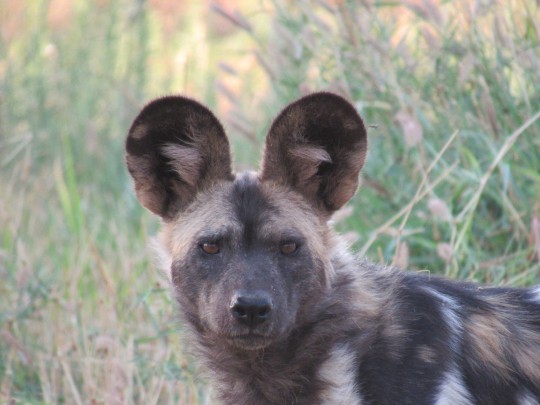


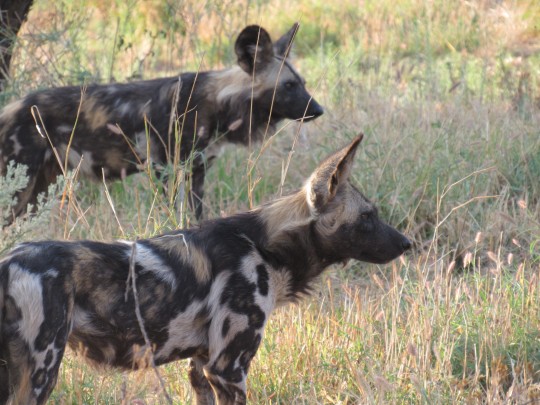
Wild Dog Wednesday! Handsome okes from Kruger, the Waterberg, and Hluhluwe-Umfolozi Reserve.
Hunting packs will kill 85% of their prey, with wide variability seen by researchers in tactics. Most common is a straight chase with a lead wolf harrying the prey. Should the antelope attempt to evade to the side, a second wolf will cut across that diagonal and take the lead on the prey. Other researchers have noted more subtle measures such as driving a herd into a trap.
By the time antelope are caught, the chase has covered several kilometers, and the exhausted prey are near collapse. The killing blow is usually evisceration which looks brutal but generally ends life quickly with catastrophic blood loss. The larger the hunting party, the swifter the kill.
Smaller groups taking down large antelope like wildebeest must struggle to immobilize and tear open the prey. People often confuse this with cruelty, as though expecting the wolf pack to bring a rifle to assuage easily upset tourists. This has led to misplaced moral judgment upon this remarkable hunter, simply for its efforts to survive in the challenging bushveld. Sympathy for the prey led to antipathy for the predator.
#south africa#africa#original photography on tumblr#wildlife photography#kruger national park#african painted dog#african wild dog#canid
6 notes
·
View notes
Text
Farewell and Hello
May 22, 2024
It’s amazing how attached one can get to the staff at a wonderful camp in just a few days. Maybe it’s the difference between two and three nights at a place, but Hoanib Skeleton Coast Camp was pretty special for their hospitality, warmth and the pride that the staff takes in the camp. It was clear several times that they are still getting over the 1 1/2 years of COVID (theirs and other camps closed, so everyone was unemployed). So many of the staff thanked us for visiting, even as we thanked them for the wonderful welcome we received. They sent us off with an equally wonderful song.
It was such a treat to be able to sleep in (to 6:30 AM!) and take our time getting ready. Seb ran to the lounge to get coffee/latte to have in the room, and then we went to breakfast a bit later. It was quiet with the group of eight already out on their morning drive. We finished packing and hung in the main lounge area for a while until Jo and Robert joined us for the short drive to the airstrip. Two flights brought us to the Ongava Game Reserve. 30,000 hectares (just over 74,000 acres) of protected land. There are several accommodations here: one tented camp, one exclusive camp with only three rooms, and the lodges where we’re staying (in the middle of exclusive and natural tented). Not bad at all for slumming, as we joked! We ran into Rebecca and Lance from Sossusvlei who shared our flight and were headed to Little Ongava, the snazzier place. We realized that between this and last trip, sometimes we were at the nice exclusive of twin facilities and sometimes at the older (but still fabulous) place, as here. The whole camp has the feel of Lewa Wilderness, a Kenya camp we stayed in on our last trip. Lots of stone, thatched roofs, paths to the bungalows. We have A/C here, but the air is fresh and it reportedly will cool down even more tonight, so we’re going with screens and fresh air!
As is the norm at camps, staff met us on arrival with cold, wet towels and a lemonade. We’re up on a hillside, so there are lots of stone steps - up to the lodge, down to the common area, down over and up to our bungalow #9. We had a late lunch in the open air restaurant overlooking an expansive vista and watering hole below. A small group of ellies, some springboks, blue wildebeests and close to us on the hillside a bunch of rock hyraxes. Lunch was delish and then we were escorted to our room. Rock hyrax babies on the way, peaking out from the rocks and making wild noises. Here, there’s WiFi in the lounge as well as the room. We found ourselves looking at email at lunch so made a pact that connectivity is off-limits in the common area - more fun chatting up the staff or other guests!!
Our room is very nice and comfortable, with a balcony overlooking the vista (through some trees). We settled in for a piece (not a lot of time) then headed back to the lodge for our afternoon game drive. We’re an international group for our vehicle: a young British couple, an older Aussie couple and us. Sylvanius is our guide for our stay. He’s very knowledgeable, if perhaps without the amazing style or sensitivity of our previous guides. Not intended as a big criticism, we guess that he’s simply less experienced in the subtler aspects of customer service and guest comfort (e.g., managing the vehicle for our comfort vice for optimal progress; relying on his colleagues’ spottings, rather than looking through binocs himself). At any rate, we recognize that every camp and every guide is different. We were out for about three hours. We did an overview drive of the private reserve. Early on, we didn’t see much, but it got better and better. The moon came out - full or almost full, and with the sun setting, the light was fantastic. First we had a group of about five white rhinos, including young ones. They were among the shrubs/low trees that one sees all over, so we only got a few clear views,but it was fun to see them between the branches, munching away. We caught some springboks and giraffes and then headed to catch “something interesting.” It turned out to be a male and female lion resting together just off a road. They were alternating napping and going into alert mode at sounds, a few yawns, and then they moved together. The girl made some fascinating grunting calls to the other three in their reported five-member pride who did not arrive by the time we took off. Sylvanius served us a sundowner so that we could hang watching them a while longer. We alternated holding each other’s drink and taking a camera to see lions and moon on one side and setting sun on the other. Let’s face it: lions in the wild simply doesan’t get old!
The drive back was chilly (ahhhh, love that feeling), and we were rewarded with cool cloths to clean up. Everyone was already seated for dinner, so we passed on a cocktail and sat down for dinner ourselves. Yay: first a rhino and then a baby rhino drank from the lighted watering hold - nice scope set up for optimal viewing. It was nice that several guests looked out for one another to make sure everyone noticed!
Dinner was yummy, a nice pinotage, and then the guy with the gun walked us back to the room, confirming on the way that yes, they’re real bullets, not tranquilizer bullets. Hard to imagine a big animal here on the hill, but who knows. We each made use of the fabulous outdoor shower, did a bit of blogging, and now off to sleep for us to be ready for an early start.
4 notes
·
View notes
Note
3, 9 and 12 for the asks! 💙💙
ahhhh ty for the ask!!
favorite line/scene you wrote this year
i was kinda surprised by how hard it actually was to narrow things down to one scene/line?? there were a few good/funny one-liners i thought about, but tbh i think the answer is a scene about my OC silas.
The beast held out something for Silas to take. His hands—much to Silas' relief—were not hoof-like in shape or texture, though they were rough and ashen gray. The object was only the size of the creature's relatively large palm, and Silas squinted down at it. What exactly it was was hard to say. It appeared, at first glance, to be an impossibly smooth, rectangular black stone. It seemed to him to be a strange offering, but perhaps this was custom in the future to which he still felt so ill-adjusted. Or perhaps it was a common tradition of horsemen—of whom Silas had only ever met this one. Either way, it felt rude not to accept. It was cool to the touch, and no thicker than a quarter inch. Its surface was a sleek black on both sides, but was clearly constructed from metal on one side and not the other. So, not a stone. Still Silas couldn't piece together what it might have been. The metallic half was the only stretch of black interrupted, with a small glass construct which looked almost like a crude recreation of an eye.
it's basically what would happen if a wildebeest mutant offered a ww1 era coal miner's kid a cell phone. i almost did it as a more of a writing exercise to get into silas' head because it's wild to think about how different the world he grew up in was. but it ended up being really fun to try at think from this totally different perspective and i liked how it turned out so! ya know :3
longest wip of the year
it's 11.5K words and 6 chapters long !!! it's not published anywhere rip, it's about my OC wes. but i've been enjoying writing it a whooolllee lot
favorite character to write about this year
i've definitely gone thru some phases this year lol. i really only wrote about like,,, three characters and all of them were my OCs but wes probably wins this year and will probably go on to continue winning, but a lot of my writing this year has been insanely self indulgent if i'm honest so it's a tight race
fanfic end of the year questions!
2 notes
·
View notes
Text
The Case of the Wacky Wildebeest.
The African Impact volunteer program for us entails numerous game drives where we record what we see. Some days we do transects to count all the animals in a set area, other days we record the big cats, elephants, hyenas, jackals, raptors and vultures. That information is put into a computer for future research projects by universities, conservation projects, etc.
As we drive we pass Maasai homesteads, children walking to school, folks on motorcycles; often three or four on one motorcycle. (Yesterday a motorcycle almost crashed depositing three children on the ground, the smallest in front of the driver held on and was not tipped off nor was the driver; probably daddy taking the kids to school. Thankfully no one was hurt. And men and women walking.
One day as we drove up a tricky little incline over a waterway, there were three men standing around. Our driver stopped to talk with them at the top of the rise in their language, Maa.
Afterwards he told us what was said. Evidently the man was complaining about a dead sheep that was killed by a wildebeest, and not the first time that had happened!
Now, a wildebeest is a ruminant, a peaceful animal only known to occasionally fight with a rival, or an animal trying to harm them or their young. Therefore this was quite unusual. I started thinking about what could cause this. My veterinary training had me thinking was it some disease like Mad Cow disease or a parasite that had entered the brain? I thought it would be very interesting to do a necropsy to examine the brain and see if there were changes.
A few days later I asked our guide/driver, Dickson, if he had heard what happened to the animal. He had reported it to the Kenya Wildlife Service. They had sent rangers out who found the animal and chased it far from that herd of sheep into a more remote area of the conservancy. (Pardamat Conservancy has 64,420 acres, 850 land owners, 0 camps and 0 beds for tourists, and 21 Rangers).
I may never know why such a pastoral animal came to kill sheep which is also a peaceful ruminant. Anyone have any ideas?

This is not a wildebeest. I find I do not have pictures of them because they are so common on the landscape. This is a Defassa water buck who is not all that common. I will take a photo of a wildebeest and post it on a later blog.
3 notes
·
View notes
Text
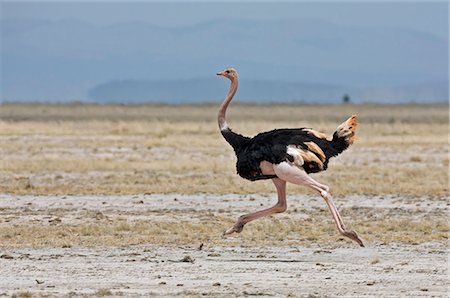
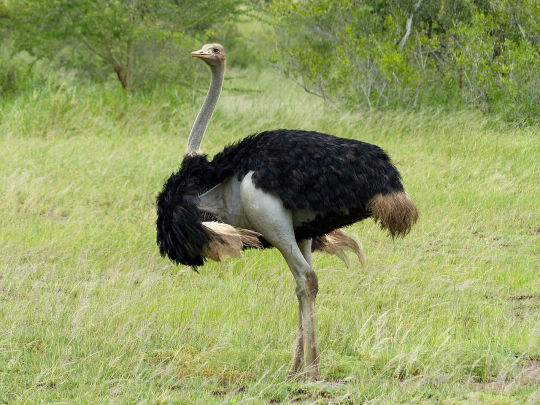
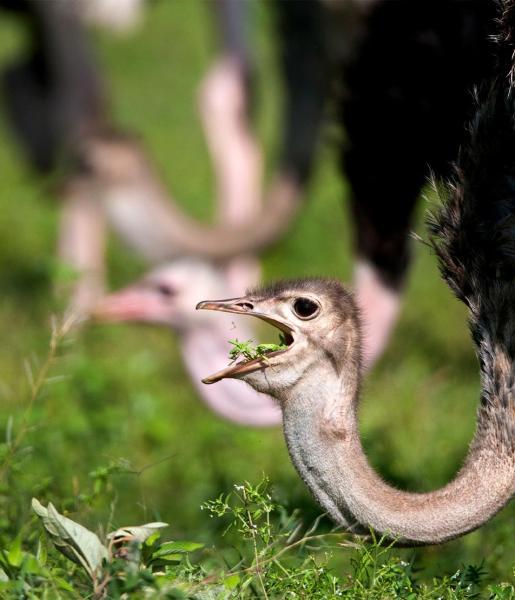

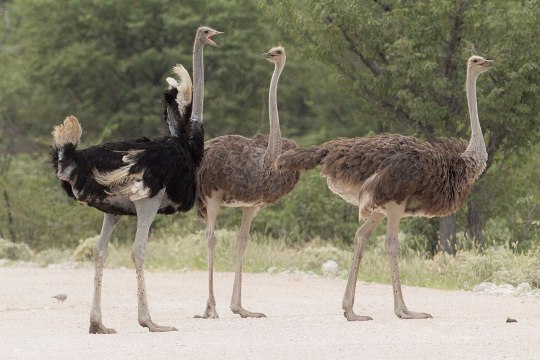
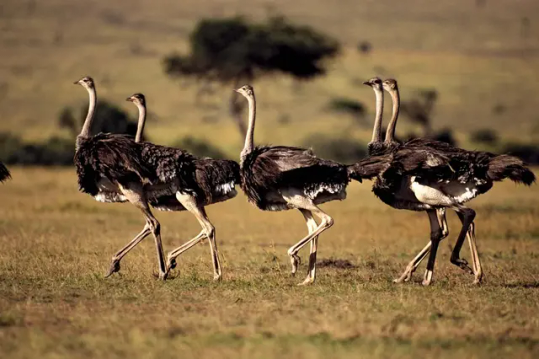
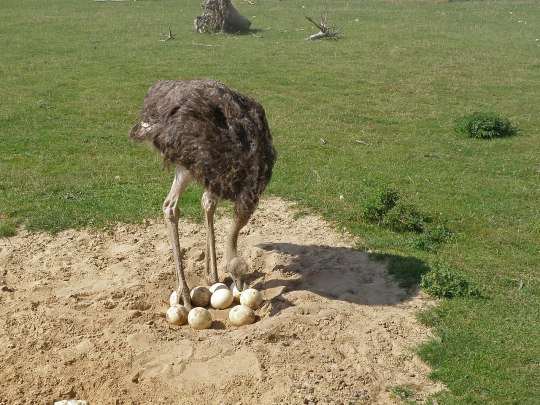
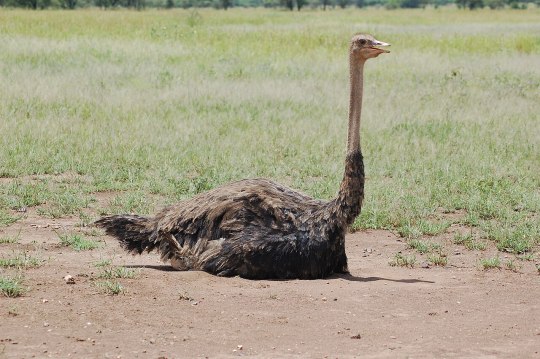
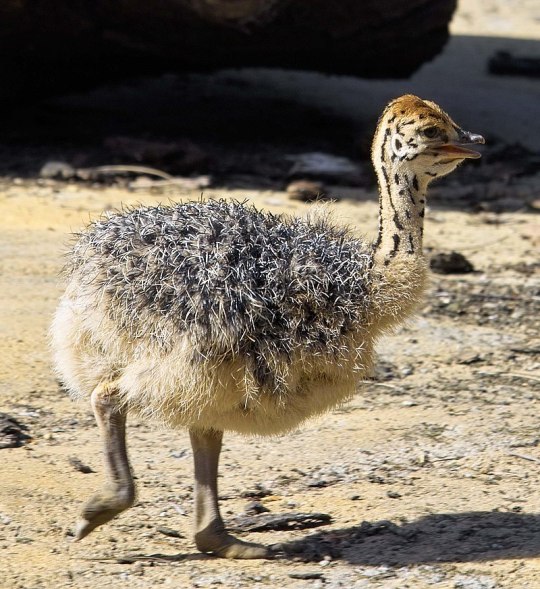
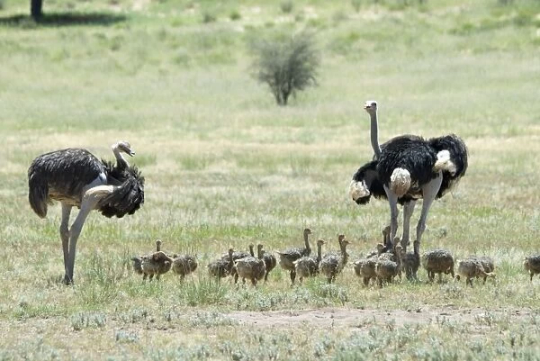
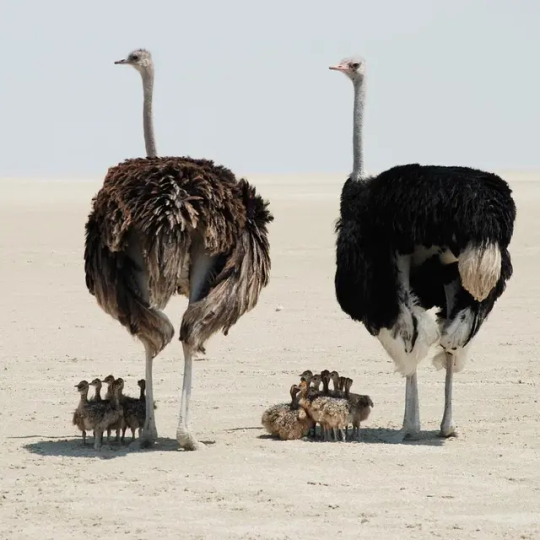
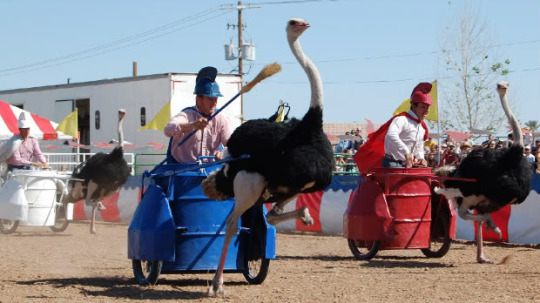
Struthio camelus, also known as the common ostrich, is a species of flightless ratite which was once native to India, the Mediterranean, and the middle east, but can now be found throughout much of Africa, with introduced populations occurring in Australia. They inhabit grasslands, scrublands, dry forests, and deserts where they feed upon various seeds, nuts, fruit, flowers, shrubs, and grasses as well as insects, small reptiles, and carrion. Common Ostriches are themselves eaten by cheetahs, lions, leopards, African hunting dogs, and hyenas. Common ostriches have many antipredator adaptations, such as great eyesight, and long muscular legs which allow them to deliver powerful kicks and run at up to 50mph (80km/h), making them the fastest animal on two legs. They also live in nomadic fission fusion flocks of up to 100 birds, which often travel alongside herbivores like wildebeest, zebra, and antelope. With females reaching around 5.9 to 6.3ft (1.75 to 1.9m) tall and 130 to 260lbs (59 to 120kgs) in weight and males reaching 7 to 9ft (2.1 to 2.75m) tall and 180 to 345lbs (82 to 156kgs) in weight, the common ostrich is the largest of all extant avians. Males have black body feathers and white feathers on their wing-tips and tails, while females have grey-brown body feathers. There necks are long, eyes and large, and feet are broad only sporting 2 toes. The mating season lasts from March to September. During such time males establish a territory, then females break into groups of 2 to 7 lead by a top hen who evaluate and select a specific male to mate with the entire breeding season. After the initial mating the male will dig a nest; a shallow dip in the ground in which the top hen will lay 7-10 eggs. Subsequently, the male will mate with all females in the group. These females will each lay their eggs around the top hen's, once around 20 to 60 eggs have been laid the top hen will incubate them during the day, while the male will incubate them at night. After 35 to 45 days, the eggs will hatch and the male will take care of the chicks until they are about 10 months old and capable to fend for themselves. Under ideal conditions a common ostrich will reach sexual maturity at 2.5 to 4.5 years old and may live up to 70.
#pleistocene pride#pliestocene pride#common ostrich#ostrich#ratite#bird#ostrich riding#ostrich racing#chariot racing#wildlife#animal facts#birds
6 notes
·
View notes